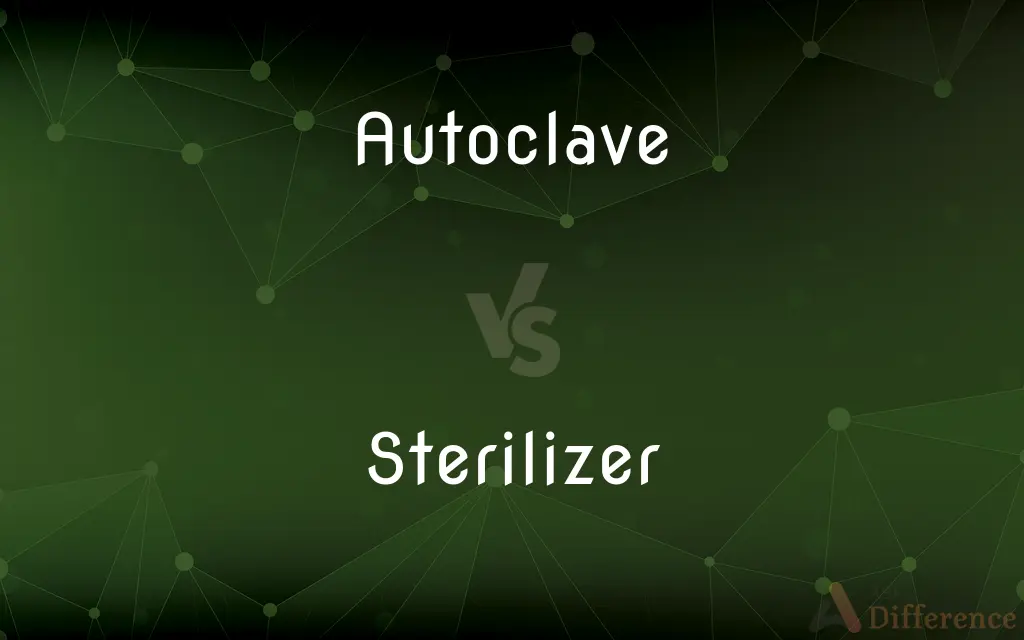Autoclave vs. Sterilizer — What's the Difference?
An autoclave is a machine that uses steam under pressure to kill harmful bacteria, viruses, and spores, while a sterilizer is a general term for any equipment or process that eliminates all forms of life and other biological agents.

Difference Between Autoclave and Sterilizer
Table of Contents
ADVERTISEMENT
Key Differences
Autoclave is a specific type of equipment that uses steam under pressure to achieve sterilization. It is especially prominent in medical and laboratory environments. On the other hand, a sterilizer refers to any equipment or method that kills or removes all forms of life, including transmissible agents like bacteria, viruses, and spores.
The concept behind an autoclave is to expose each item to direct steam contact at a controlled temperature and pressure for a specified amount of time. The key variables for effective sterilization using an autoclave include temperature, pressure, and time. In contrast, a sterilizer can utilize various methods, including heat, chemicals, irradiation, high pressure, or filtration, to achieve its objective.
When professionals in the medical field refer to an autoclave, they often mean a steam-based sterilization unit that is crucial for ensuring surgical instruments and other tools are free of living organisms. However, when they mention a sterilizer, it could mean a myriad of devices, including an autoclave, or methods meant for the same purpose - eliminating biological contaminants.
It's worth noting that while all autoclaves are sterilizers, not all sterilizers are autoclaves. An autoclave specifically uses steam to kill harmful agents, while sterilizers have various modalities at their disposal.
Autoclave operation requires meticulous attention to procedural standards and regular maintenance to ensure its efficacy. Sterilizers, depending on their type, might have different protocols and operational standards to ensure optimal performance.
ADVERTISEMENT
Comparison Chart
Definition
A machine that uses steam under pressure to kill harmful agents.
Any equipment or process that eliminates all forms of life and other biological agents.
Mechanism
Utilizes steam under pressure.
Can use heat, chemicals, irradiation, high pressure, or filtration.
Common Usage
Predominantly in medical and laboratory settings.
Various settings depending on the type and method of sterilization.
Specificity
A specific type of sterilizer.
A general term encompassing various equipment and methods.
Maintenance & Protocol
Requires specific procedural standards and regular maintenance for efficacy.
Depending on type, might have different protocols and operational standards.
Compare with Definitions
Autoclave
A pressurized device that sterilizes objects using steam.
The hospital uses an autoclave to sterilize surgical instruments.
Sterilizer
A process or device ensuring the elimination of bacteria, viruses, and spores.
The water sterilizer ensures safe drinking water for the community.
Autoclave
Equipment operating under specific temperature, pressure, and time to achieve sterilization.
The autoclave's settings are critical for its proper function.
Sterilizer
Equipment used to kill or remove all forms of life, including transmissible agents.
Hospitals invest in high-quality sterilizers to maintain a safe environment.
Autoclave
A device ensuring direct steam contact for sterilization.
Ensure that objects in the autoclave are positioned for maximum steam exposure.
Sterilizer
A term encompassing various equipment and techniques for sterilization.
The clinic employs multiple sterilizers, from chemical solutions to heat-based units.
Autoclave
A machine prevalent in medical settings for ensuring tools are free of living organisms.
It's vital to autoclave the dental tools after each patient's use.
Sterilizer
Any method or device that eliminates biological contaminants.
This UV light acts as an effective sterilizer for the room.
Autoclave
A steam-based sterilization unit.
The laboratory autoclave ensures all glassware is free from contaminants.
Sterilizer
Any system that eradicates all forms of biological agents.
In the lab, they use a specialized sterilizer for sensitive equipment.
Autoclave
An autoclave is a machine used to carry out industrial and scientific processes requiring elevated temperature and pressure in relation to ambient pressure/temperature. Autoclaves are used in medical applications to perform sterilization and in the chemical industry to cure coatings and vulcanize rubber and for hydrothermal synthesis.
Sterilizer
To make free from live bacteria or other microorganisms.
Autoclave
A strong, pressurized, steam-heated vessel, as for laboratory experiments, sterilization, or cooking.
Sterilizer
To eliminate the ability of a person or animal to produce offspring, as by altering or removing the reproductive organs.
Autoclave
A strong, pressurized, heated vessel, as for laboratory experiments, sterilization, cooking or mineral processing.
Sterilizer
To make incapable of bearing fruit or germinating.
Autoclave
(transitive) To sterilize laboratory equipment in an autoclave.
Sterilizer
To render (land) unfruitful.
Autoclave
(cryptography) autokey
Sterilizer
(Economics) To place (gold) in safekeeping so as not to affect the supply of money or credit.
Autoclave
A kind of French stewpan with a steam-tight lid.
Sterilizer
To make inoffensive or innocuous
Sterilized the terminology with euphemisms.
Autoclave
A device used for sterilizing objects by exposing them to steam at above atmospheric pressure (and thus at a temperature above the normal boiling point of water). It consists of a closed chamber able to withstand internal pressure, and a means of passing superheated steam into the chamber. Autoclaves are made in various sizes, and are much used in hospitals and research laboratories to render instruments and equipment sterile.
Sterilizer
A device used to sterilize, killing pathogens by means such as heat, UV light, chemicals, etc.
The hospital was in trouble when the sterilizer broke; they almost had to shut down the operating room.
Autoclave
A device for heating substances above their boiling point; used to manufacture chemicals or to sterilize surgical instruments
Sterilizer
One that sterilizes anything; specif., an apparatus for sterilizing equipment or an organic fluid.
Autoclave
Subject to the action of an autoclave
Sterilizer
A device for heating substances above their boiling point; used to manufacture chemicals or to sterilize surgical instruments
Common Curiosities
What is an autoclave primarily used for?
An autoclave is primarily used for sterilizing objects using steam under pressure.
Are there different types of sterilizers?
Yes, there are various types of sterilizers, including heat, chemical, irradiation, and filtration-based methods.
How is a sterilizer different from an autoclave?
A sterilizer is a general term for any method or equipment that eliminates biological agents, while an autoclave is a specific type of sterilizer that uses steam.
Is steam the only medium used in an autoclave for sterilization?
An autoclave primarily uses steam under pressure for sterilization.
In which settings might you commonly find an autoclave?
Autoclaves are commonly found in medical, dental, and laboratory settings.
Is an autoclave more effective than other sterilizers?
Effectiveness varies by application; an autoclave is highly effective for its intended use but may not replace other sterilizers in different scenarios.
Can a UV light be considered a sterilizer?
Yes, a UV light can be considered a sterilizer as it kills or removes biological contaminants.
What happens if an autoclave doesn't operate under the right conditions?
If an autoclave doesn't operate under the correct conditions, it might not effectively sterilize objects, posing a risk.
Can you use an autoclave to sterilize liquids?
Yes, autoclaves can sterilize liquids, but specific protocols should be followed to prevent liquid from boiling over or bursting.
Why is the pressure critical in an autoclave?
Pressure ensures steam penetrates objects deeply and efficiently, achieving thorough sterilization.
Why is it vital to maintain an autoclave properly?
Proper maintenance ensures the autoclave's efficacy in sterilizing objects and preventing the spread of harmful agents.
Can a chemical solution act as a sterilizer?
Yes, certain chemical solutions can act as sterilizers when used appropriately.
Are all autoclaves the same size?
No, autoclaves come in various sizes depending on their intended use and capacity needs.
Are there alternatives to the autoclave in medical settings?
Yes, while autoclaves are common, other sterilizers, like chemical sterilants or UV sterilizers, may also be used depending on the context.
How does one know if a sterilizer, like an autoclave, has effectively sterilized objects?
Indicators, tests, and regular maintenance checks help verify the effectiveness of sterilizers, including autoclaves.
Share Your Discovery

Previous Comparison
Romanichal vs. Gypsy
Next Comparison
Implementation vs. Onboarding















































